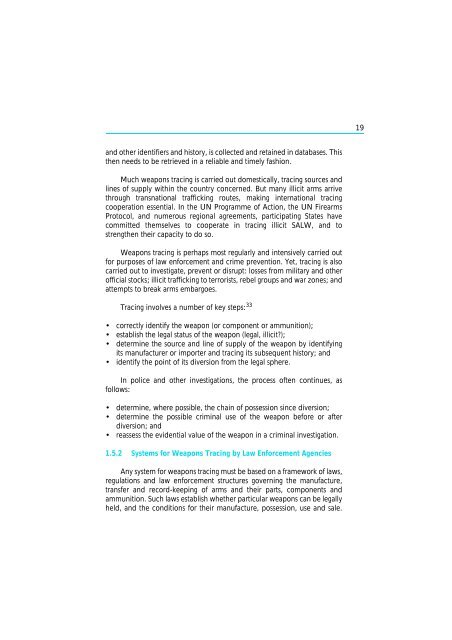The Scope and Implications of a Tracing Mechanism for Small Arms ...
The Scope and Implications of a Tracing Mechanism for Small Arms ...
The Scope and Implications of a Tracing Mechanism for Small Arms ...
Create successful ePaper yourself
Turn your PDF publications into a flip-book with our unique Google optimized e-Paper software.
19<br />
<strong>and</strong> other identifiers <strong>and</strong> history, is collected <strong>and</strong> retained in databases. This<br />
then needs to be retrieved in a reliable <strong>and</strong> timely fashion.<br />
Much weapons tracing is carried out domestically, tracing sources <strong>and</strong><br />
lines <strong>of</strong> supply within the country concerned. But many illicit arms arrive<br />
through transnational trafficking routes, making international tracing<br />
cooperation essential. In the UN Programme <strong>of</strong> Action, the UN Firearms<br />
Protocol, <strong>and</strong> numerous regional agreements, participating States have<br />
committed themselves to cooperate in tracing illicit SALW, <strong>and</strong> to<br />
strengthen their capacity to do so.<br />
Weapons tracing is perhaps most regularly <strong>and</strong> intensively carried out<br />
<strong>for</strong> purposes <strong>of</strong> law en<strong>for</strong>cement <strong>and</strong> crime prevention. Yet, tracing is also<br />
carried out to investigate, prevent or disrupt: losses from military <strong>and</strong> other<br />
<strong>of</strong>ficial stocks; illicit trafficking to terrorists, rebel groups <strong>and</strong> war zones; <strong>and</strong><br />
attempts to break arms embargoes.<br />
<strong>Tracing</strong> involves a number <strong>of</strong> key steps: 33<br />
• correctly identify the weapon (or component or ammunition);<br />
• establish the legal status <strong>of</strong> the weapon (legal, illicit?);<br />
• determine the source <strong>and</strong> line <strong>of</strong> supply <strong>of</strong> the weapon by identifying<br />
its manufacturer or importer <strong>and</strong> tracing its subsequent history; <strong>and</strong><br />
• identify the point <strong>of</strong> its diversion from the legal sphere.<br />
In police <strong>and</strong> other investigations, the process <strong>of</strong>ten continues, as<br />
follows:<br />
• determine, where possible, the chain <strong>of</strong> possession since diversion;<br />
• determine the possible criminal use <strong>of</strong> the weapon be<strong>for</strong>e or after<br />
diversion; <strong>and</strong><br />
• reassess the evidential value <strong>of</strong> the weapon in a criminal investigation.<br />
1.5.2 Systems <strong>for</strong> Weapons <strong>Tracing</strong> by Law En<strong>for</strong>cement Agencies<br />
Any system <strong>for</strong> weapons tracing must be based on a framework <strong>of</strong> laws,<br />
regulations <strong>and</strong> law en<strong>for</strong>cement structures governing the manufacture,<br />
transfer <strong>and</strong> record-keeping <strong>of</strong> arms <strong>and</strong> their parts, components <strong>and</strong><br />
ammunition. Such laws establish whether particular weapons can be legally<br />
held, <strong>and</strong> the conditions <strong>for</strong> their manufacture, possession, use <strong>and</strong> sale.
















